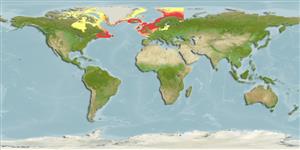Common names from other countries
Environment: milieu / climate zone / depth range / distribution range
Ecología
; rango de profundidad 0 - 600 m (Ref. 78657). Temperate, preferred 11°C (Ref. 107945); 85°N - 36°N, 110°W - 45°E
Arctic, Northern Atlantic and the Mediterranean: Canadian Arctic Archipelago and the Atlantic Ocean. Temperate to polar climates.
Length at first maturity / Tamaño / Peso / Age
Maturity: Lm ?, range 5 - 7.2 cm Max length : 10.2 cm SHL macho / no sexado; (Ref. 360); common length : 5.1 cm SHL macho / no sexado; (Ref. 360)
Shell: not very thick, solid, conical spire, generally high, sometimes rather flattened spires, very convex whorls and markedly impressed suture; ovoidal aperture, outer lip is not thickened or toothed, lacks inner folds; columellar lip has a fairly striking callus, partly adheres to the ventral surface of the body whorl; sculpture has almost equidistant spiral grooves and quite big axial ribs that tend to fade at the edge of the body whorl and are generally sinous; yellowish white or light hazel in color; periostracum is light chestnut in color and not very resistant; operculum is horny, smaller than the aperture, has a central nucleus. Body: large foot, whole body cream with blackish patches; head has a pair of tentacles with an eye at the base of each, long proboscis; well-developed siphon; radula is rachnioglossan.
Maximum depth from Ref. 106864.
Life cycle and mating behavior
Madurez | Reproducción | Puesta | Huevos | Fecundidad | Larva
Females gather in groups to deposit eggs in a communal mass of egg capsules where veligers develop and metamorphose inside and later hatch out as young individuals (Ref. 360).
Harms, J. 1993. (Ref. 2711)
IUCN Red List Status (Ref. 130435: Version 2024-1)
CITES status (Ref. 108899)
Not Evaluated
Not Evaluated
Human uses
Pesquerías: comercial
FAO - pesquerías: landings, species profile | FishSource | Sea Around Us
Herramientas
Fuentes de Internet
Estimates based on models
Preferred temperature
(Ref.
115969): 7 - 11.8, mean 9.8 (based on 337 cells).
Resiliencia
Medio, población duplicada en un tiempo mínimo de 1.4-4.4 años (K=0.2-0.22; tm=7.5).
Prior r = 0.57, 95% CL = 0.37 - 0.85, Based on 1 data-limited stock assessment.
Vulnerability
Moderate to high vulnerability (53 of 100).
